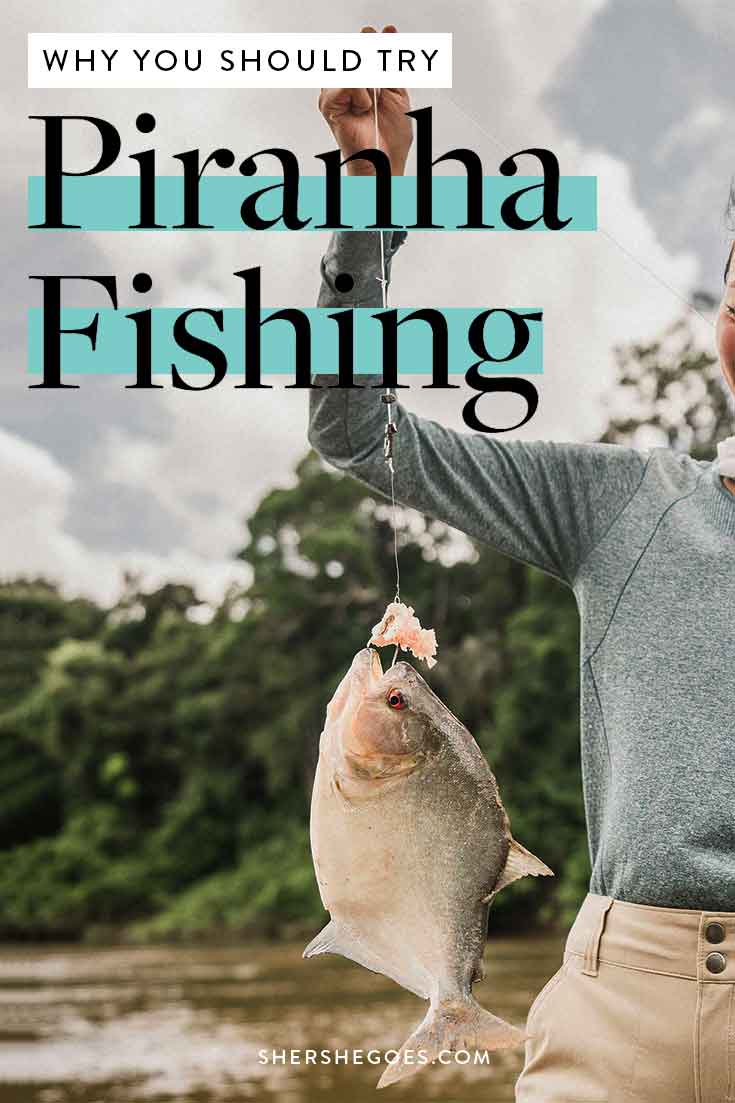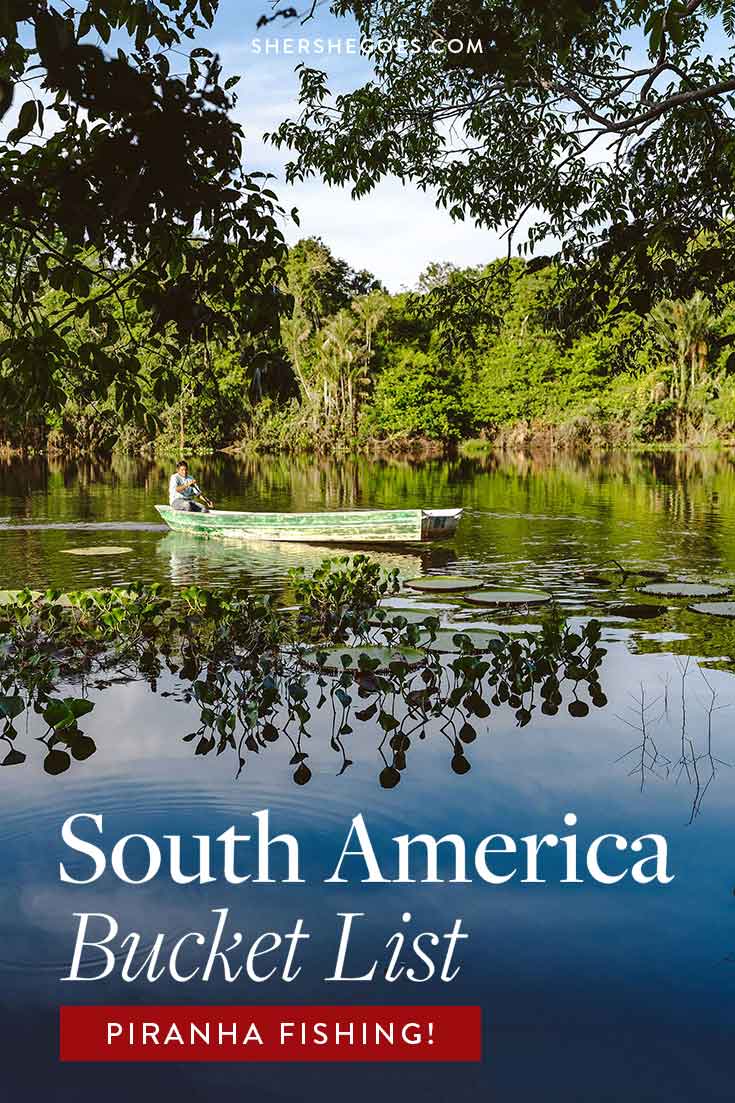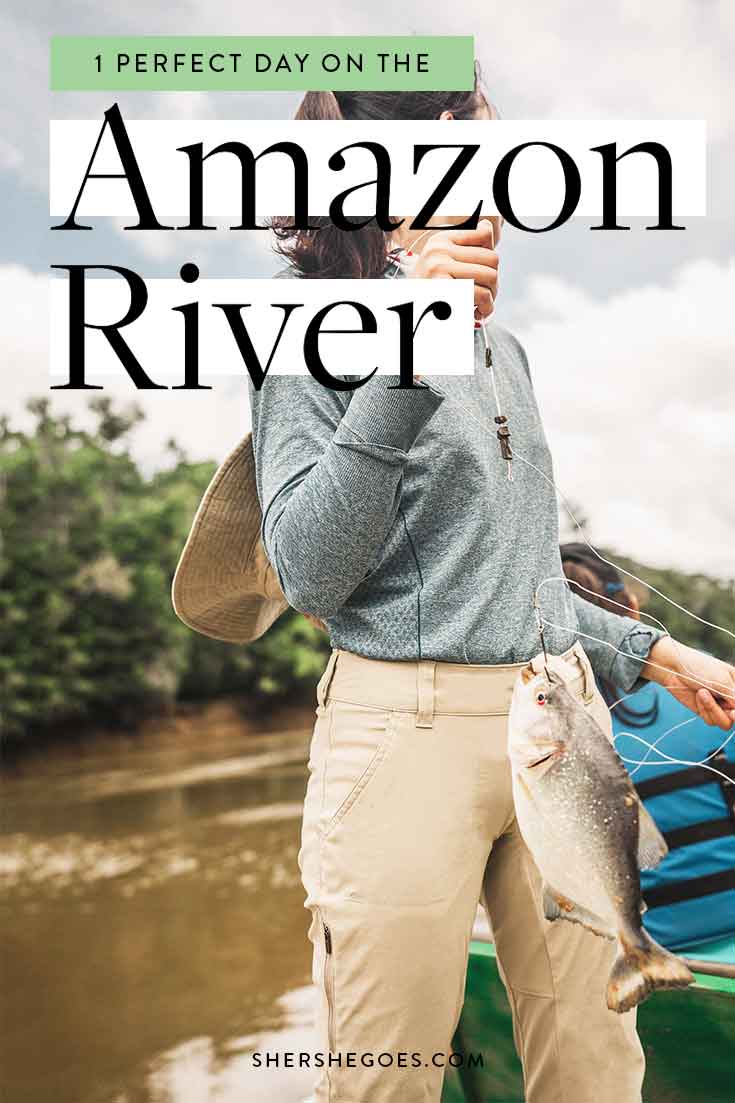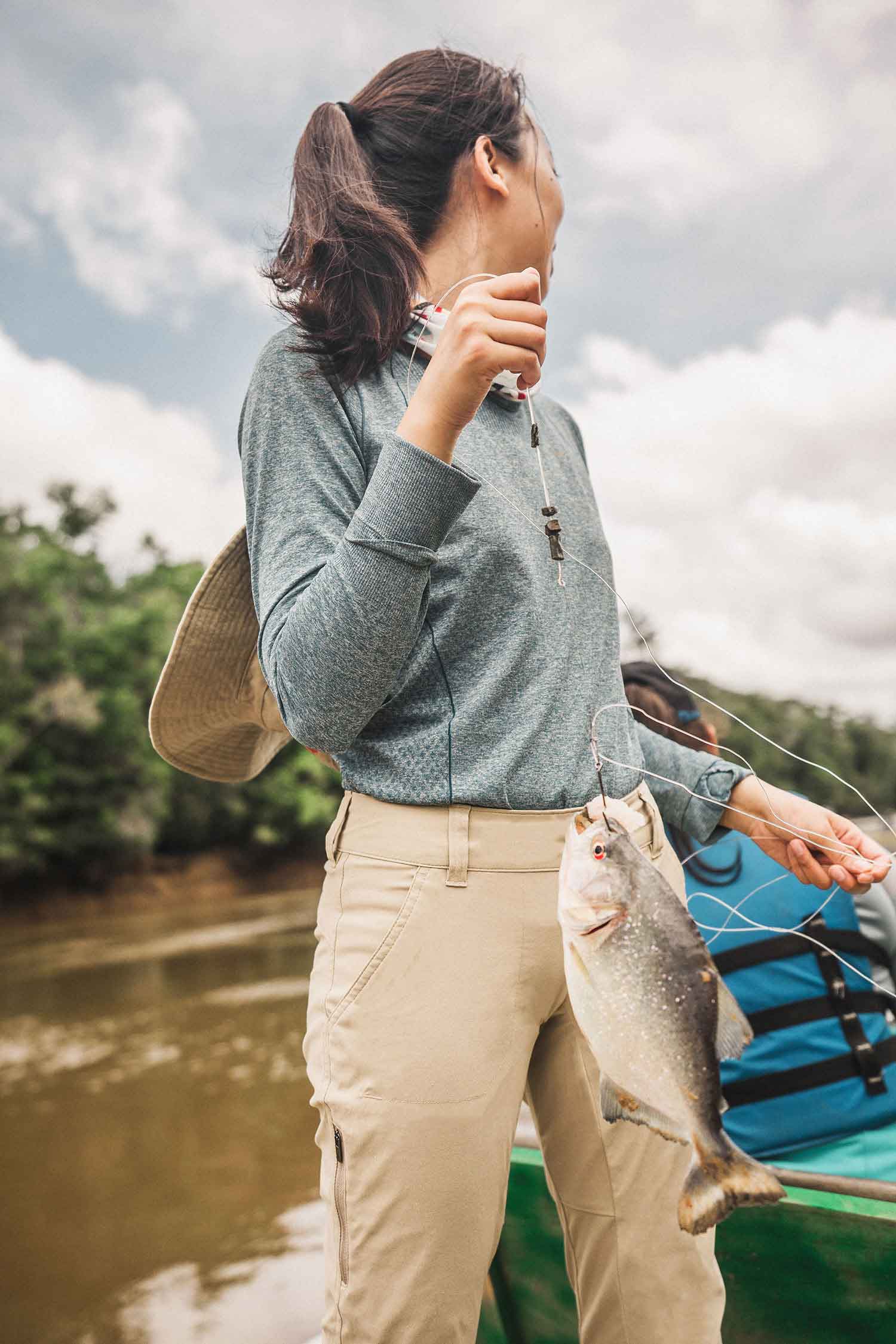Piranha Fishing
I was hot, sticky and constantly stumbling over twigs and branches. It was day 2 of our stay in the North Rupununi and I wasn’t so sure if I was cut out for this adventure.
“What’s on the agenda for today?” I asked.
“Piranha fishing!” our sprightly guide responded. He was a staff member at Rewa Lodge, the community run lodge we were staying at, and the friendliest of the team assigned to our group.
Throughout the 4 days we spent with the local Amerindian tribe, we often wondered if they looked at us with disbelief and pity. How could a group of women shriek so much and be so unaccustomed to living off the land?
ADVERTISEMENT
Ha. I think they probably anticipated a hardcore group of adventure travelers. Or maybe some serious anglers – the fishing in these rivers was apparently some of the best in the world.
We certainly didn’t fit any of those qualifications but we had a fun group and a spirit for adventure, so we listened intently as our guides began their instructions. By the end of the afternoon, we had split into two groups and the race was on: which boat could catch the most piranha in 2 hours?
Keep reading or save this article for later ⇟



ADVERTISEMENT
Fishing for Piranhas in the Amazon
It turns out fishing for piranha is quite simple.
You don’t need any fancy gear – in fact, we used simple sticks, taken straight from the forest and whittled down smooth, along with a big line of fishing wire.
The best rods come from the yari yari tree, which has flexible yet strong wood and a small diameter. Our guides cut each rod down to roughly 8 feet.
If you happened to be all alone in the wilderness, you could easily live off the land to catch yourself a hearty meal of piranha. (In fact, Naked and Afraid was filmed in the very same riverbanks just a month prior.)
ADVERTISEMENT



Piranha Bait
Once the fishing sticks are made, we learned how to find bait. Piranha love fresh bait. In order to find a hunky piece of meat for them, we started small and worked our way up, almost like a series of russian dolls.
First our guides showed us how to locate fallen nuts from the kokerit fruit tree. When the nuts fall to the ground and get buried for a month, baby larva like to nestle inside. They pale squirmy bugs are considered a delicacy among the local tribe and our guide devoured one whole just to watch us scream.
Beetle grub brought us tiny shallow fish, which in turn caught us small fish and eventually medium meaty fish. With bait and stick in hand, we were ready.
Our group of 5 split up into 2 boats (of course, with our trusty guides to help us) and the competition began!
ADVERTISEMENT
How to Catch Piranha Fish
While we’re certainly not piranha fishing experts, we did learn a thing or two on that afternoon! Mostly thanks to our Rewa guides, who were the best of the best. As part of their guide training, they learn to survive in the wilderness for days with nothing more than a machete.
Here’s how to go fishing for piranha:

Step 1: Bait Your Hook with a Meaty Chunk
Piranha aren’t picky eaters, but they are discerning. You’ll want to use a nice chunk of raw meet. Don’t skimp out on them or they won’t bite. Try to opt for a sizeable portion of fresh, bloody meat.
Any animal will do – we used fish. Twist the meat around the hook so that it’s secure. You want the hook to be entwined with the bait so that when the piranha bite down, they’re caught on the line.
Step 2: Drop and Thrash
If you’re fishing with a stick and fishing line, drop the rod about 10-15 feet deep. As the meat sinks, use a friend or a second hand to beat the surface of the water. The commotion helps attract the attention of fish and let them know to come on over – dinner’s ready!
ADVERTISEMENT

Step 3: Be Patient, But Alert
With piranha fishing, you never know what you’ll get. Sometimes the fish will bite right away and sometimes you can have a leisurely conversation with your boat-mates while you wait.
But the second you feel any kind of tug or tension, jerk the pole up and sideways to snag the fish! In the beginning, we lost tons of bait to wily piranha who escaped with their meal and left us hanging.
Once you successfully pull them out of the water, you still have to be careful. Piranha are strong, floppy fish and they’d often leap all over our boat. Because of their gigantic teeth, no one wanted to get too close to get them off the line, so we had our guides help us out.
Fishing in Guyana is done sustainably so if the caught piranha were too small, we’d often throw them back, keeping only the largest. And of course, any fish we caught and kept – we ate. No waste out in the jungle!
ADVERTISEMENT

Step 4: Accept Failure
Pretty early into our fishing day, one of our fishing rods, aka sticks, snapped in half from a particularly heavy fish. We lost the fish back into the river, adding further insult to injury.
So for a good hour, I learned how to line fish. What’s that you ask? Drop simple fishing line into the water and want for a bite. Man, that was hard.
With just fishing line, you want to lower the bait much deeper in the water, about 30-50 feet deep. Many times I felt a bite but was too slow to pull the wire completely out of the water. It definitely takes some practice to fish for piranha, so don’t be too upset if it takes a while! Patience is key.
For a good hour, Silvia and I had only caught 1 fish while the other boat was happily counting 10, 15, 20 fish hooked. It looked to be a pretty one sided competition.
ADVERTISEMENT

Instead of catching fish, we felt like we were feeding them. Time and time again, the sneaky piranha were experts at eating our bait and leaving us hook free.
Step 5: GREAT SUCCESS!
Eventually, we learned the feel of a phantom tug and a real bite and learned how to pull swiftly and strongly.
Once we each caught one, it was like a switch had turned on and we caught another after another! Since everything in Rewa is done sustainably, we kept the biggest fish and turned inland to set up for lunch.
ADVERTISEMENT
What do Piranha Taste Like
After a couple fun hours, we had caught enough fish and the sun was blazing, so we stopped for lunch. We pulled the boats back to the riverbank and our guides got to work setting up the most elaborate cooking fire… out of scratch.
They assembled sticks, built a pyre, cleaned and skewered the piranha and even brought a collection of rubs and spices to marinate the fish. It was one of the most fascinating things to see come to life – and so quickly!
ADVERTISEMENT



It turns out piranha taste quite delicious roasted over an open fire. But they can be a bit hard to eat. In addition to their razor sharp jaw, they’re filled with tiny bones. Yet another reason to throw back the smaller fish and keep only the large piranha – you’ll find you have to work for your meal!
To me, they tasted like any other soft white fish. The spicy rub that our guides added to the fish made it taste fantastic, especially with cassava and beans!
Read more: Everything We Ate in Guyana
ADVERTISEMENT
What Are Piranha?
Throughout our fishing day, we tried every technique under the sun, moved positions several times and caught some unexpected varieties of fish. Our guides were a wealth of information and we learned quite a bit about piranha that day.
It turns out there are lots of different types of piranha! These freshwater fish can be found throughout the Amazon basin. There are over 30 documented species and they’re pretty small – about 5 to 10 inches in length. In the Guyana Shield however, you can find much larger piranha!
ADVERTISEMENT



Red Bellied Piranha
To me, piranha looked quite dinosaur like, with viscous teeth and large buggy eyes. When you pull them out of the water, their eyes even glow a bit red and they emit these strange growling noises. While they don’t look quite so fierce on the line, once you pull their lips down, you’ll find a row of razor sharp teeth and a lower jaw so strong it can crush bone.
Piranha can be found in all types of colors (yellow, grey, black) and patterns, but we seemed to catch mostly red bellied piranha.
Here are some fun facts about piranhas so you can impress the rest of the group when you go piranha fishing!
ADVERTISEMENT
Piranhas Live in Protective Packs
A group of piranhas is called a shoal. They can bunch together in groups of up to 1,000!
While Hollywood would have you believe they hunt in packs, the reality is more of a defensive strategy. Young piranhas are the meal of choice for caimans, turtles, otters, large birds and other fish, so schooling together helps them protect the young at the center and fend off predator attacks.
Piranhas Don’t Really Eat Humans
The movie Piranha has crafted an image of flesh eating predators that devour living creatures in seconds, in big bloody frenzies. In reality, piranhas are actually omnivores and feed mostly on insects, snails, plants and other fish.
They’re especially triggered by blood in the water. Similar to sharks, piranhas have special sensory organs that allow them to sense blood in the water. They’ll usually only attack larger mammals or birds if they’re injured, dying and have fallen into the water. With that being said, we still kept our fingers and toes firmly within the canoe.
ADVERTISEMENT
But Their Teeth Are Incredibly Strong
Piranha have an unusually large lower jaw for fish. Their mouths are lined with razor like teeth that are as sharp as a shark’s – which contributes to an impressive bite force. With their teeth, piranha can pierce metal and bone.
They also shed their teeth frequently and regrow them in chunks! So while these fish don’t eat humans, you do want to be careful when getting them off the line. It’s quite common for them to bite fingers and take a piece of flesh with them. Our guides showed us some scars on their hands that had come from piranha bites.
Different piranha species are also known to be more or less docile. The black and red bellied piranhas are considered the most hostile – the exact types we were fishing in Guyana!
ADVERTISEMENT
What to Wear Fishing in Guyana
We heard from our Rewa guides that serious anglers love Guyana for its unique fish. The North Rupununi rivers are home to the Arapaima, the largest freshwater fish in the world and a huge draw for sport fishermen. I’m sure if you’re one of those you already know what to bring!
This packing list is more for the regular people, like us, that just want to try piranha fishing for the day. It gets SO HOT in Guyana that we recommend booking an early morning tour. We set out around 8 am and by the time we had crafted the sticks, caught our bait and settled in for the actual piranha fishing, the sun was overhead and we were sweltering.
Be sure to pack:
Piranha fishing was the highlight of our trip to the Rupununi. Definitely add this excursion on if you’re headed anywhere near the Amazon river!
Visiting Guyana – Trip Planning Checklist
Flight Deals | Caribbean Airlines offers nonstop flights from New York and Miami to Georgetown. You can set a fare alert here to be notified of discounts.
Getting Around | Book a driver for Georgetown or a tour to handle transportation in the Amazon basin. Most arrangements must be set up in advance, for minimum parties of 4, due to the high cost of gas and overland vehicles as well as the limited internet communication in the jungle.
Accommodation | In Guyana's interior, accommodation is remote and consists of comfortable but simple eco-lodges run by local communities. Many do not have internet access, so it's best to book a tour package that will handle transportation, activities and accommodation for you. Or, you can call to make reservations online. In Georgetown, there are plenty of boutique and international hotels to choose from.
Insurance | Lastly, be sure to visit Guyana with travel insurance. Hospitals and medical assistance are scarce in the jungle interior and yellow fever vaccinations are strongly recommended. Whether you get injured and need to be hospitalized, or your phone gets stolen, travel insurance will help when you need it most. Get a quote for your trip here.
You Might Also Enjoy:
Guyana Vacation Planning Articles
Quick Guide to Guyana
What to Pack for the Amazon Jungle Clothes + Recommended Gear
2 Weeks in the Guiana Shield: Our Guyana Itinerary
Explore All the Best Things to Do in Guyana
Visiting Georgetown: What to See & Do in Guyana's Capital!
Guyana's Interior: The Amazon Basin
Day Trip to Kaieteur, the World's Longest Free Falling Waterfall
Day Tour: Learning How to Fish for Piranha in the Amazon
Guyanese Food: What to Expect, Where to Eat & More!
Guyanese Culture & It's Amerindians
Photos of Guyana from our trip!
Follow me @Sher She Goes on







1 Comment